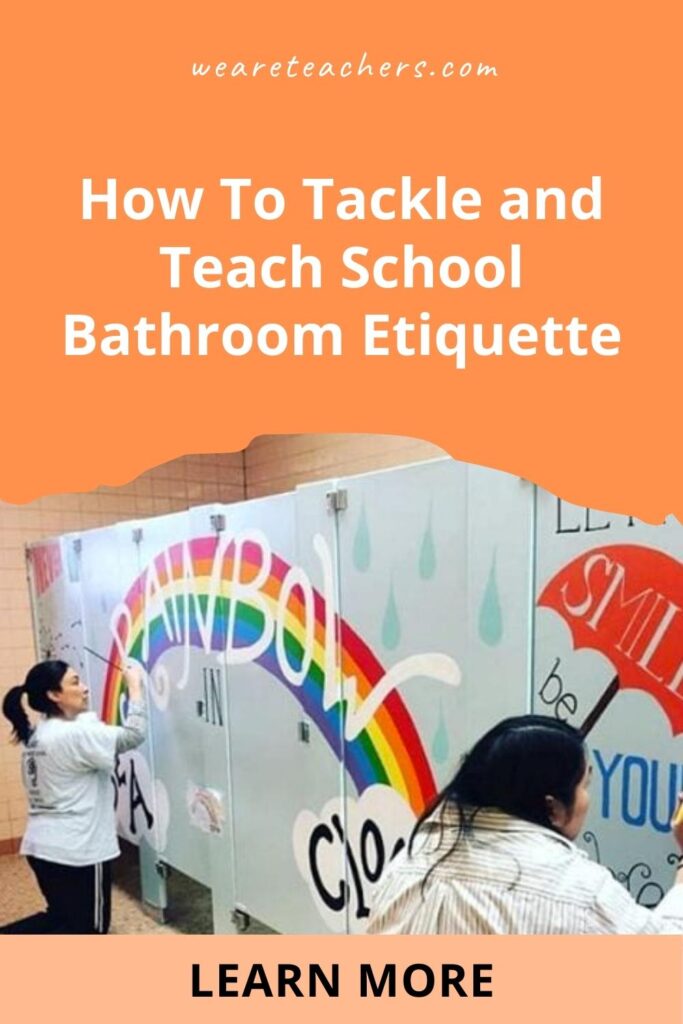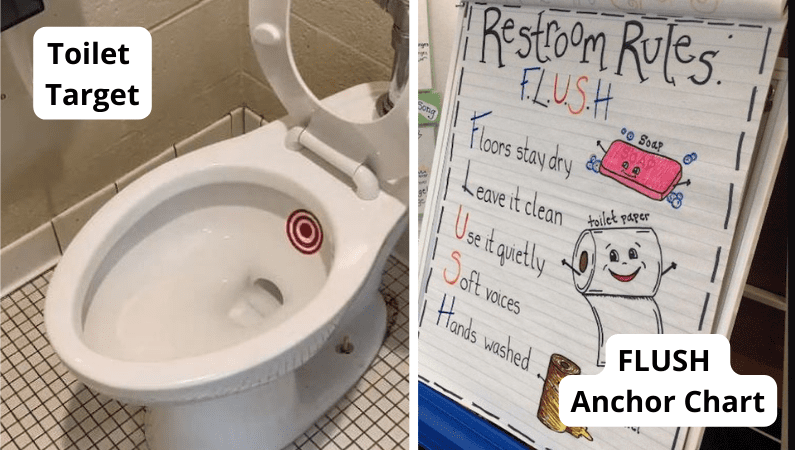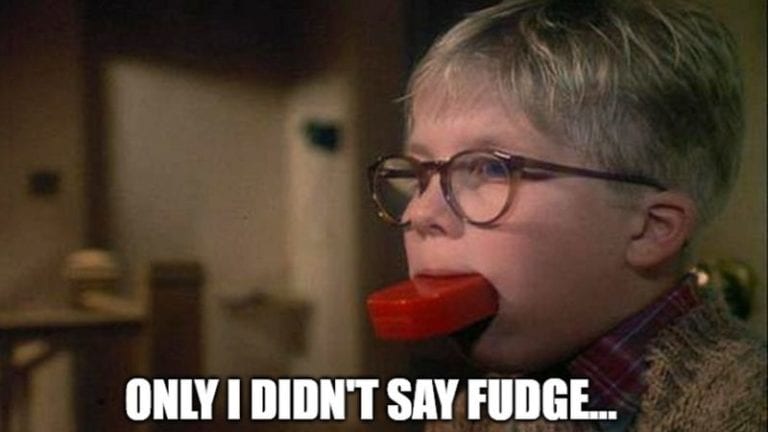If the phrase “school bathroom” makes you shudder, you’re not alone. Public restrooms are notoriously iffy at the best of times, and school bathrooms can be some of the worst. Some of the gross factor can be chalked up to kids who are too little to know better. In other cases, it’s a lack of respect on the part of students. Whatever the case, school bathroom etiquette is a topic you’re bound to have to tackle from time to time. Here’s some straight talk on handling this tough issue.
School Bathroom Talk Tips
Here are some general things to keep in mind when talking about school bathroom etiquette.
Be clear and straightforward.
Don’t dance around the subject; say what you need to say. Kids need to hear the specifics. “We all need to help keep the bathroom clean,” sounds pleasant, but might not help. Instead, name the issue and the change you want to see: “Sometimes people leave pee on the seats. You may need to wipe your seat with toilet paper when you’re done.” It might feel awkward, but these are normal human functions. Talking about them reminds students that, well, everyone poops.
Use language kids will understand.
On that same note, avoid the temptation to use “delicate” language, especially with little kids. Use “pee” instead of “urinate” and “poop” instead of “feces.” The famous book isn’t called Everyone Defecates, and for good reason.
Be gender sensitive.
When discussing bathroom issues, don’t make gender assumptions. Instead of “boys have trouble with aim,” use language like “people who stand up to pee are more likely to miss.”
Teaching School Bathroom Etiquette
For the kindergarten and early elementary crowd, public bathrooms are still a fairly new environment. And while it may seem like something their parents should be covering, that’s just not always the case. Like so many other things in life, it’s all about learning the right routines. So try some of these bathroom behavior lessons, activities, and ideas from other teachers.
FLUSH Anchor Chart
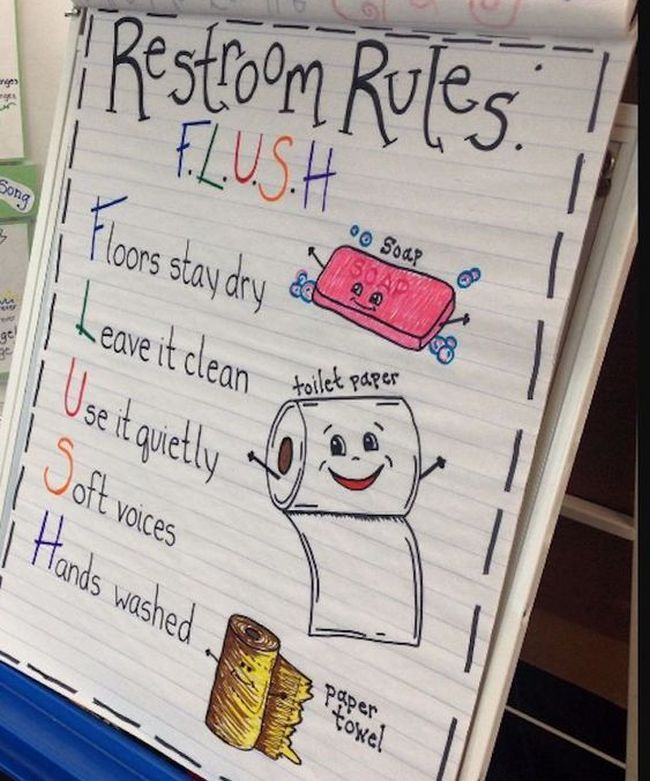
We’re not sure who first created this anchor chart, but it’s a perennial favorite on Pinterest to help teach school bathroom etiquette. The FLUSH acronym covers a lot of the most important bathroom behaviors, and it’s easy for kids to remember.
Pocket Chart Sort
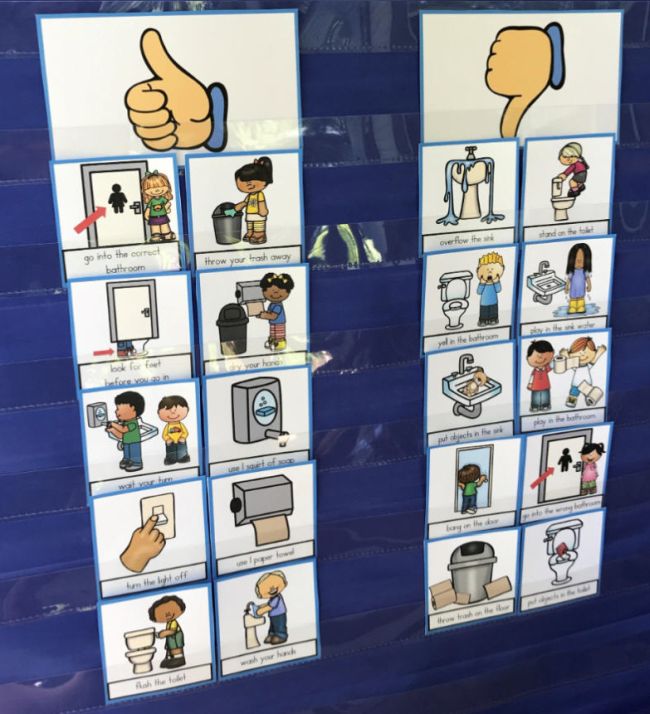
This sorting activity lays out both good and bad bathroom etiquette. Talk about each as you sort them with your students, then leave the results up as a reminder for future restroom visits.
Learn more: Crystal McGinnis on Teachers Pay Teachers
Bathroom Social Stories
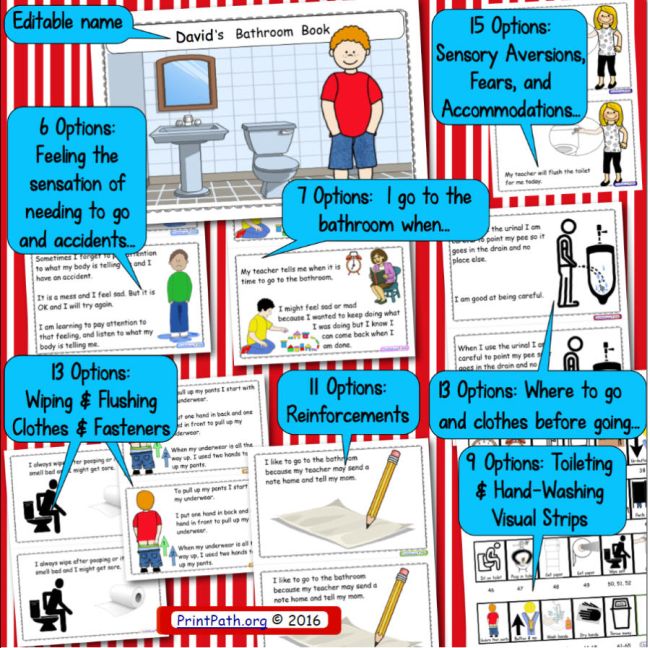
These editable stories can be customized to fit your school and students. There’s so much information here that kids need to know.
Learn more: Boys Bathroom Social Stories and Girls Bathroom Social Stories by Print Path OT on Teachers Pay Teachers
“Going to the Bathroom at School” Book
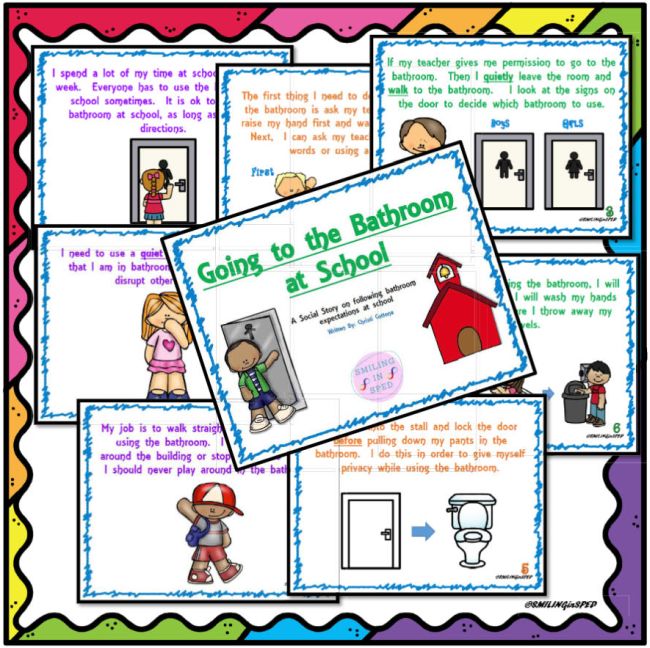
This printable book has a nice focus on using the bathroom specifically at school. It’s perfect for the first week of school, as you’re establishing routines.
Learn more: SMILING in SPED on Teachers Pay Teachers
Bathroom Social Skills Activities
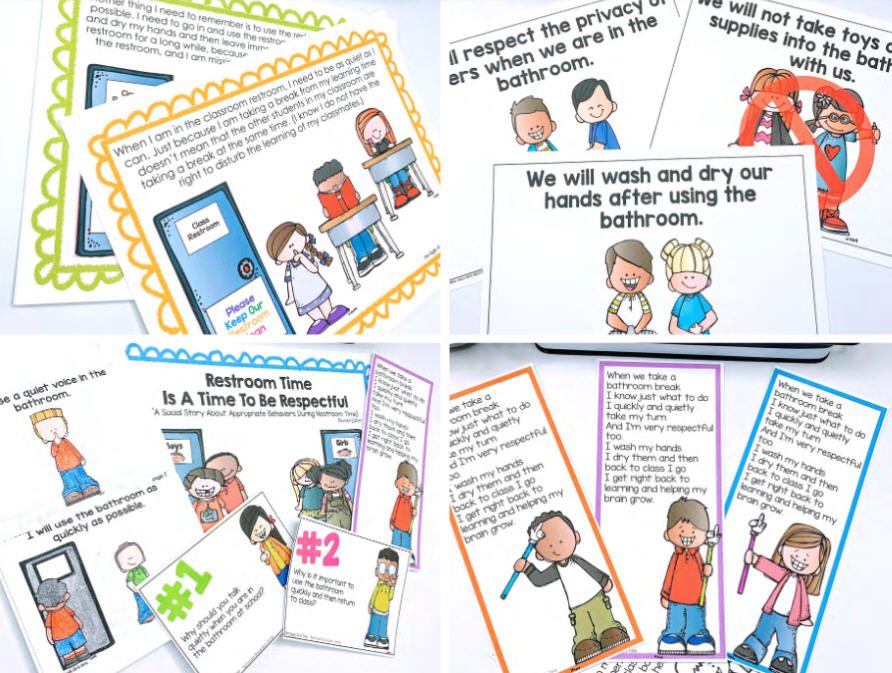
This pack includes lots of terrific resources, including signs, discussion cards, a mini-book, and more.
Learn more: One Giggle at a Time on Teachers Pay Teachers
Basic Bathroom Signs
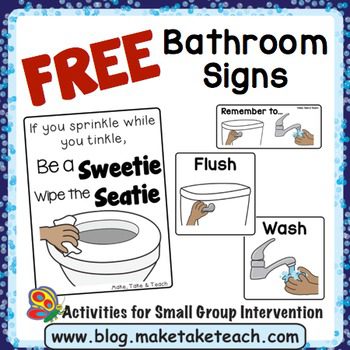
Hang these free printable signs as reminders of the right way to behave in the school bathroom.
Learn more: Make Take Teach on Teachers Pay Teachers
“I Gotta Go” Bathroom Song
This catchy song covers a lot of the skills kids need to be responsible bathroom users. Use it as part of a lesson, or sing it during morning meetings.
School Restroom Procedures Video
The teachers and students at Lynch Wood Elementary made a fun video about the best bathroom practices. Kids will get a giggle and learn something too.
School Bathroom Problems and Solutions
These are some of the biggest restroom issues schools face and ideas for fixing them.
Students are misusing the urinals.
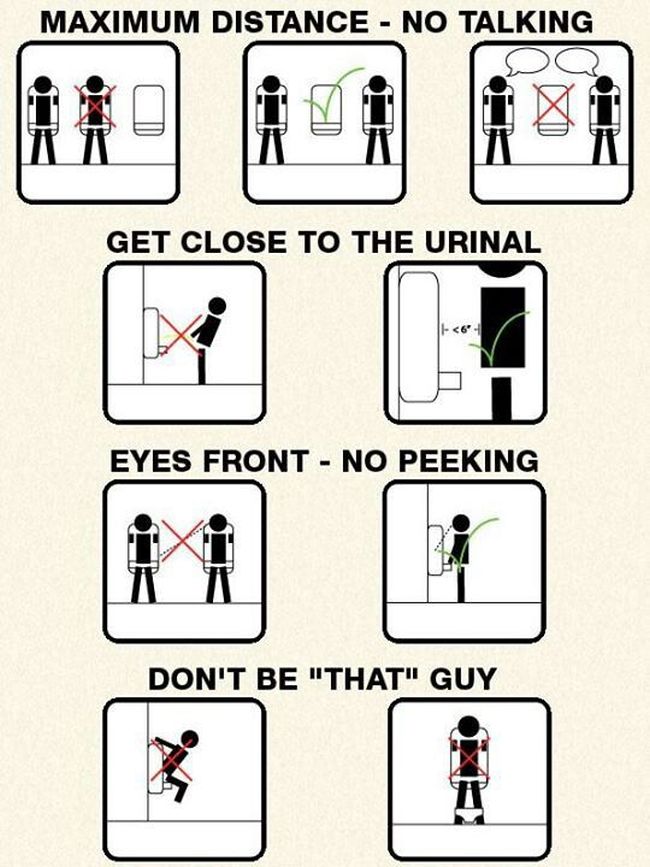
This is a piece of bathroom equipment that most kids won’t have at home, and it’s possible that no one has ever shown them how to use one properly. So start young, and teach kids how a urinal works. (Don’t be afraid to teach all kids, regardless of gender. Take the mystery out of the bathroom!) If you’re not a urinal user, try to find someone who is to talk to kids about this topic.
There are pee spots on the seats or floor.
In small amounts, this is almost always accidental. As we noted above, those who stand up to pee don’t always have great aim. The Kindergarten Smorgasboard offers this solution: a toilet target.
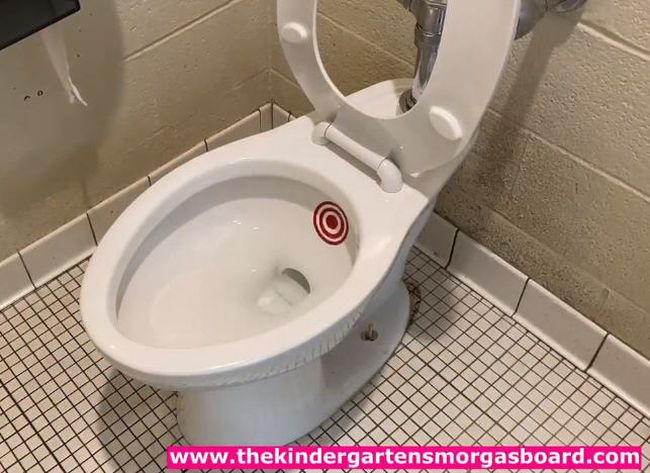
It’s also important to remind kids to lift the seat if they’re not going to sit down on it (but put it back down when they’re done, so others don’t fall in and get hurt). And be honest with them: Sometimes we all make a bit of a mess. Grab some TP and wipe it up. It’s that easy.
What about pee floods and poop smears?
True teacher story from the WeAreTeachers HELPLINE: “The cleaner came in after school to the faculty office and was very upset over the literal sea of urine on the floor. She believes it was intentional and to be honest, I wouldn’t be surprised.”
Other teachers in the discussion have seen the same thing. Their recommendations?
- “Made my boys watch the poor janitor clean it out. Told them that is someone’s grandfather … what if it were yours?!”
- “We have kids (both boys and girls) at my high school who think it’s funny to trash the bathrooms. I’ve suggested to the principal that, when caught, the guilty parties be made to clean the school for a week.”
- “I talked about it with students. I reminded them that sooner or later someone would be caught and have to face the consequences, and it would be so humiliating.”
Kids gather in the bathroom to play and mess around.
Bathrooms are one place at school where kids feel unsupervised, so it’s not surprising they tend to congregate there and fool around. Some schools control this by limiting how long a student can spend in a bathroom or the number of kids in there at one time. But that generally requires some kind of monitor, and teachers are so busy already.
Teacher Julia B. got creative. “My third grade boys are famous for wanting to hang out in the bathroom,” she shared on the WeAreTeachers HELPLINE. “We’d find them climbing on stalls, laying on the floor, etc. So last week I had our custodian rub this piece of bread all over the bathroom. Needless to say, they don’t want to hang out there anymore.”
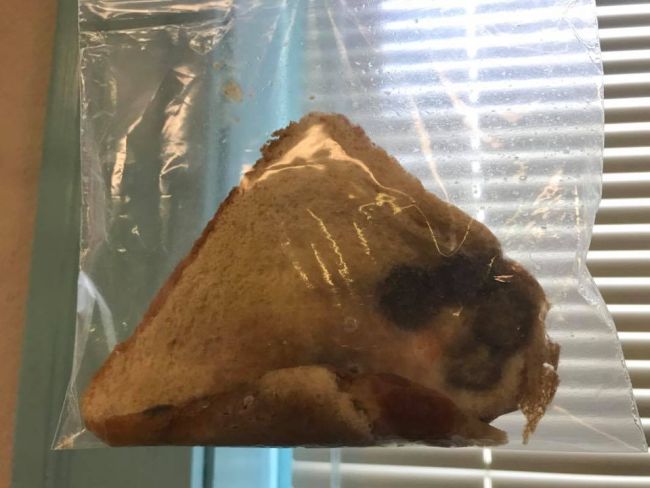
Kids are wasting paper and soap.
Some of this comes down to teaching bathroom routines (see suggestions above). Talk to kids about the cost of supplies, and show them exactly how much soap and paper they really need to wash their hands properly.
When it comes down to it, though, you might just want to be glad that they’re actually remembering to wash their hands!
Students vandalize the restrooms.
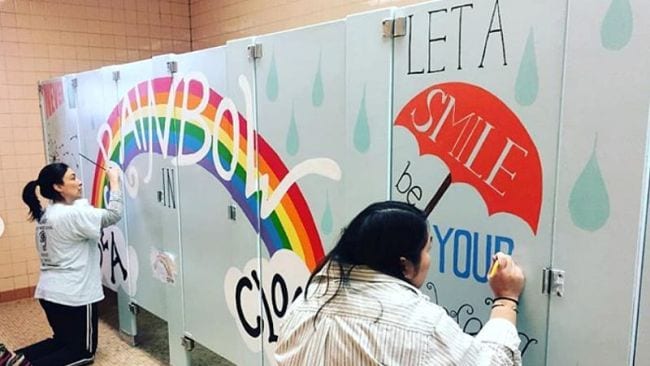
This is a really tough one, and it’s been a problem for years. Schools have taken a variety of approaches to this.
- Lock the bathrooms and require a key that must be signed out at the main office. This allows schools to limit each bathroom to one student at a time, and you’ll get a pretty good idea of who might be doing the vandalizing.
- Close the bathrooms entirely. Be very cautious about employing an approach like this. “Just hold it” isn’t an option for everyone, and there could be legal issues too.
- Employ bathroom monitors. Teachers might take turns (as with lunch or parking lot duty), or you can hire school aides. You could also consider a parent volunteer policy.
- Make the bathroom a better place. This might sound a little counterintuitive, but some schools have found that sprucing up their restrooms actually encourages kids to behave a little better. Try painting murals like the one shown above (find more great ideas here).
Students don’t feel safe in the bathroom.
School bathrooms have been the scene for all kinds of bullying and harassment, from “swirlies” to sexual assault. Every school needs a zero-tolerance policy for that kind of behavior. Ensure students know who to report bullying or abusive behavior to, no matter where it takes place.
Want to talk to other teachers about how they handle school bathroom etiquette? Drop by the WeAreTeachers HELPLINE group on Facebook!
Plus, check out 8 DIY Activities To Teach Kids About Germs.
